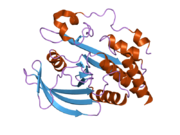PTPN3
| PTPN3 | |||||||||||||||||||||||||||||||||||||||||||||||||||
|---|---|---|---|---|---|---|---|---|---|---|---|---|---|---|---|---|---|---|---|---|---|---|---|---|---|---|---|---|---|---|---|---|---|---|---|---|---|---|---|---|---|---|---|---|---|---|---|---|---|---|---|
 | |||||||||||||||||||||||||||||||||||||||||||||||||||
| |||||||||||||||||||||||||||||||||||||||||||||||||||
| Identifiers | |||||||||||||||||||||||||||||||||||||||||||||||||||
| Aliases | PTPN3, PTP-H1, PTPH1, protein tyrosine phosphatase, non-receptor type 3, protein tyrosine phosphatase non-receptor type 3 | ||||||||||||||||||||||||||||||||||||||||||||||||||
| External IDs | OMIM: 176877; MGI: 105307; HomoloGene: 74451; GeneCards: PTPN3; OMA:PTPN3 - orthologs | ||||||||||||||||||||||||||||||||||||||||||||||||||
| |||||||||||||||||||||||||||||||||||||||||||||||||||
| |||||||||||||||||||||||||||||||||||||||||||||||||||
| |||||||||||||||||||||||||||||||||||||||||||||||||||
| |||||||||||||||||||||||||||||||||||||||||||||||||||
| |||||||||||||||||||||||||||||||||||||||||||||||||||
| Wikidata | |||||||||||||||||||||||||||||||||||||||||||||||||||
| |||||||||||||||||||||||||||||||||||||||||||||||||||
Tyrosine-protein phosphatase non-receptor type 3 is an enzyme that in humans is encoded by the PTPN3 gene.[5][6]
Function
The protein encoded by this gene is a member of the protein tyrosine phosphatase (PTP) family. PTPs are known to be signaling molecules that regulate a variety of cellular processes including cell growth, differentiation, mitotic cycle, and oncogenic transformation. This protein contains a C-terminal PTP domain and an N-terminal domain homologous to the band 4.1 superfamily of cytoskeletal-associated proteins. P97, a cell cycle regulator involved in a variety of membrane related functions, has been shown to be a substrate of this PTP. This PTP was also found to interact with, and be regulated by adaptor protein 14-3-3 beta.[6]
Interactions
PTPN3 has been shown to interact with YWHAB.[7]
References
- ^ a b c GRCh38: Ensembl release 89: ENSG00000070159 – Ensembl, May 2017
- ^ a b c GRCm38: Ensembl release 89: ENSMUSG00000038764 – Ensembl, May 2017
- ^ "Human PubMed Reference:". National Center for Biotechnology Information, U.S. National Library of Medicine.
- ^ "Mouse PubMed Reference:". National Center for Biotechnology Information, U.S. National Library of Medicine.
- ^ Yang Q, Tonks NK (August 1991). "Isolation of a cDNA clone encoding a human protein-tyrosine phosphatase with homology to the cytoskeletal-associated proteins band 4.1, ezrin, and talin". Proc Natl Acad Sci USA. 88 (14): 5949–53. Bibcode:1991PNAS...88.5949Y. doi:10.1073/pnas.88.14.5949. PMC 51999. PMID 1648725.
- ^ a b "Entrez Gene: PTPN3 protein tyrosine phosphatase, non-receptor type 3".
- ^ Zhang SH, Kobayashi R, Graves PR, Piwnica-Worms H, Tonks NK (October 1997). "Serine phosphorylation-dependent association of the band 4.1-related protein-tyrosine phosphatase PTPH1 with 14-3-3beta protein". J. Biol. Chem. 272 (43): 27281–7. doi:10.1074/jbc.272.43.27281. PMID 9341175.
Further reading
- Arimura Y, Hinoda Y, Itoh F, Takekawa M, Tsujisaki M, Adachi M, Imai K, Yachi A (1992). "cDNA cloning of new protein tyrosine phosphatases in the human colon". Tumour Biol. 13 (3): 180–6. doi:10.1159/000217763. PMID 1626183.
- Ikuta S, Itoh F, Hinoda Y, Toyota M, Makiguchi Y, Imai K, Yachi A (1995). "Expression of cytoskeletal-associated protein tyrosine phosphatase PTPH1 mRNA in human hepatocellular carcinoma". J. Gastroenterol. 29 (6): 727–32. doi:10.1007/BF02349278. PMID 7874267. S2CID 31617297.
- Itoh F, Ikuta S, Hinoda Y, Arimura Y, Ohe M, Adachi M, Ariyama T, Inazawa J, Imai K, Yachi A (1994). "Expression and chromosomal assignment of PTPH1 gene encoding a cytosolic protein tyrosine phosphatase homologous to cytoskeletal-associated proteins". Int. J. Cancer. 55 (6): 947–51. doi:10.1002/ijc.2910550612. PMID 8253532. S2CID 32380202.
- Zhang SH, Kobayashi R, Graves PR, Piwnica-Worms H, Tonks NK (1997). "Serine phosphorylation-dependent association of the band 4.1-related protein-tyrosine phosphatase PTPH1 with 14-3-3beta protein". J. Biol. Chem. 272 (43): 27281–7. doi:10.1074/jbc.272.43.27281. PMID 9341175.
- Zhang SH, Liu J, Kobayashi R, Tonks NK (1999). "Identification of the cell cycle regulator VCP (p97/CDC48) as a substrate of the band 4.1-related protein-tyrosine phosphatase PTPH1". J. Biol. Chem. 274 (25): 17806–12. doi:10.1074/jbc.274.25.17806. PMID 10364224.
- Gjörloff-Wingren A, Saxena M, Han S, Wang X, Alonso A, Renedo M, Oh P, Williams S, Schnitzer J, Mustelin T (2000). "Subcellular localization of intracellular protein tyrosine phosphatases in T cells". Eur. J. Immunol. 30 (8): 2412–21. doi:10.1002/1521-4141(2000)30:8<2412::AID-IMMU2412>3.0.CO;2-J. PMID 10940933. S2CID 8132613.
- Zheng Y, Schlondorff J, Blobel CP (2003). "Evidence for regulation of the tumor necrosis factor alpha-convertase (TACE) by protein-tyrosine phosphatase PTPH1". J. Biol. Chem. 277 (45): 42463–70. doi:10.1074/jbc.M207459200. PMID 12207026.
- Sozio MS, Mathis MA, Young JA, Wälchli S, Pitcher LA, Wrage PC, Bartók B, Campbell A, Watts JD, Aebersold R, Hooft van Huijsduijnen R, van Oers NS (2004). "PTPH1 is a predominant protein-tyrosine phosphatase capable of interacting with and dephosphorylating the T cell receptor zeta subunit". J. Biol. Chem. 279 (9): 7760–9. doi:10.1074/jbc.M309994200. PMID 14672952.
- Blanchetot C, Chagnon M, Dubé N, Hallé M, Tremblay ML (2005). "Substrate-trapping techniques in the identification of cellular PTP targets". Methods. 35 (1): 44–53. doi:10.1016/j.ymeth.2004.07.007. PMID 15588985.
- Benzinger A, Muster N, Koch HB, Yates JR, Hermeking H (2005). "Targeted proteomic analysis of 14-3-3 sigma, a p53 effector commonly silenced in cancer". Mol. Cell. Proteomics. 4 (6): 785–95. doi:10.1074/mcp.M500021-MCP200. PMID 15778465.
- Jespersen T, Gavillet B, van Bemmelen MX, Cordonier S, Thomas MA, Staub O, Abriel H (2006). "Cardiac sodium channel Na(v)1.5 interacts with and is regulated by the protein tyrosine phosphatase PTPH1". Biochem. Biophys. Res. Commun. 348 (4): 1455–62. doi:10.1016/j.bbrc.2006.08.014. PMID 16930557.
- Jing M, Bohl J, Brimer N, Kinter M, Vande Pol SB (2007). "Degradation of tyrosine phosphatase PTPN3 (PTPH1) by association with oncogenic human papillomavirus E6 proteins". J. Virol. 81 (5): 2231–9. doi:10.1128/JVI.01979-06. PMC 1865939. PMID 17166906.
- Töpffer S, Müller-Schiffmann A, Matentzoglu K, Scheffner M, Steger G (2007). "Protein tyrosine phosphatase H1 is a target of the E6 oncoprotein of high-risk genital human papillomaviruses". J. Gen. Virol. 88 (Pt 11): 2956–65. doi:10.1099/vir.0.83123-0. PMID 17947517.
- v
- t
- e
-
 2b49: Crystal Structure of the Catalytic Domain of Protein Tyrosine Phosphatase, non-receptor Type 3
2b49: Crystal Structure of the Catalytic Domain of Protein Tyrosine Phosphatase, non-receptor Type 3
 | This article on a gene on human chromosome 9 is a stub. You can help Wikipedia by expanding it. |
- v
- t
- e




















